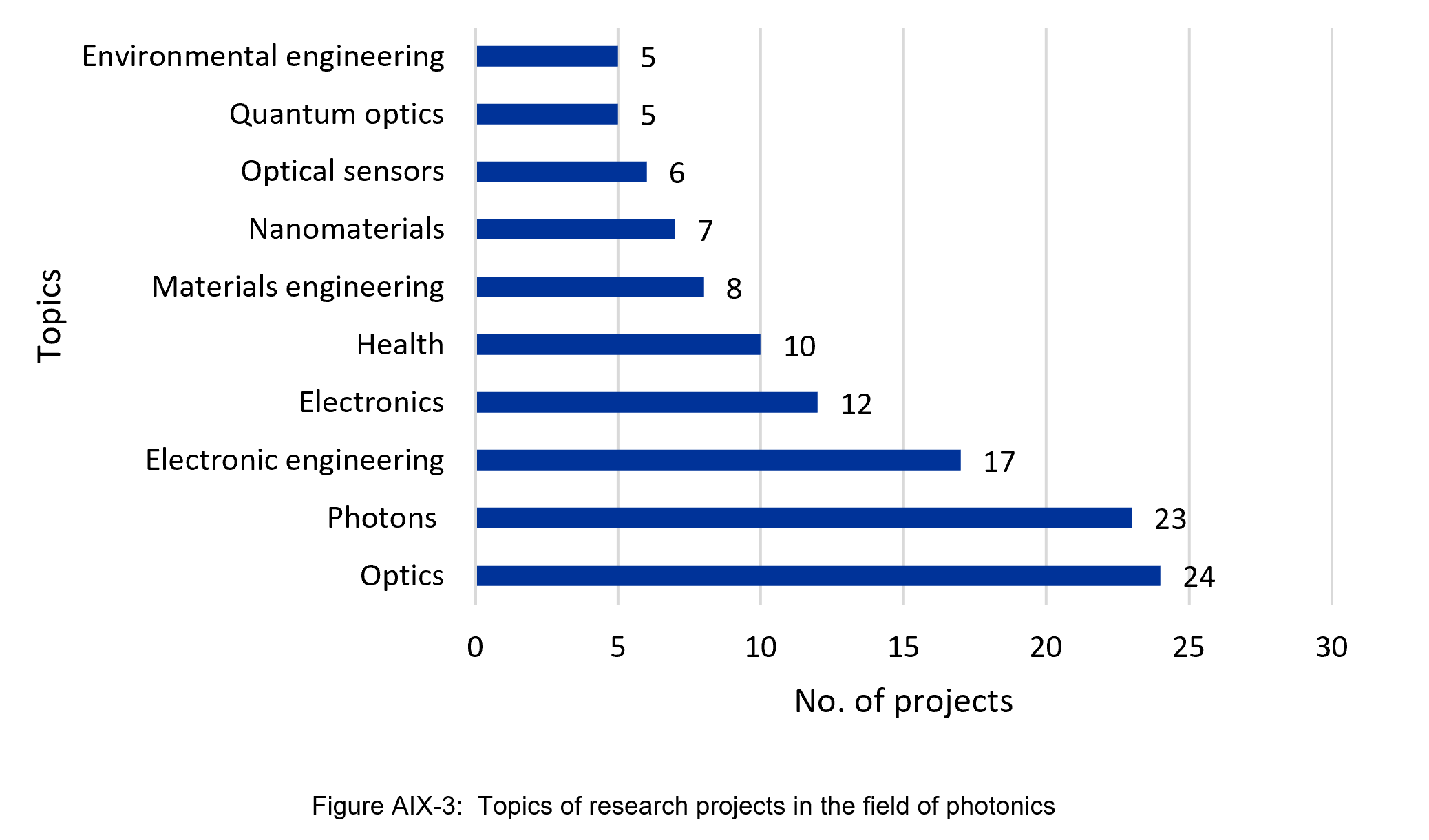R&D - EUON
Photonics
This section gives an overview of the Horizon 2020 projects focused on photonics. In research classification used by Cordis database, photonic research and applications can be located under the following classifications: ‘physical sciences/ optics’ and ‘physical sciences/ theoretical physics/ particle physics/ photons’, ‘engineering and technology/ nanotechnology/ nanophotonics’. The projects that contained the above-mentioned subject classifications were filtered out from the general collection of nanotechnology projects developed for the study. The titles and abstracts of the projects were manually read to check if a project relates to photonics.
However, optics is a wider field and some projects related to photonics did not contain the above-mentioned classifications. For this reason, project titles and abstracts were inspected. Those that contained a mention of photonics were selected for the analysis.
In the period 2017-2020, Horizon 2020 funded 62 projects in the field of photonics. The photonics projects comprised 5% of all research projects in nanotechnology funded by the EU in 2017-2020. In general, it shows a modest interest in photonics and nanotechnology.
Analysis of the start date of photonics projects shows that most of them received funding and started in 2017 and 2018. H2020 covered the 2014-2020 period, so with 2017 as a mid-term of the programme, it is not surprising that most projects started during this period. The decreasing number of research projects towards the end of the funding period is explained by the fact that most research projects require several years to complete.

H2020 contained several high-level programmes/priorities/specific actions and their sub-programmes. Three thematic and two horizontal high-level programmes funded nanotechnology research and innovation:
- Priority “Excellent science” (1) aimed to improve the excellence of the European research base and consolidate the European Research Area (ERA) to increase the global competitiveness of European research and innovation.
- Priority “Industrial leadership” (2) focused on boosting the development of the technologies and innovations that will underpin future businesses and help innovative European SMEs to grow into world-leading companies. This priority contained a sub-programme targeted at nanotechnologies.
- Priority “Societal challenges” (3) focused on the societal challenges that were identified in the Europe 2020 strategy and aimed to encourage sufficient research and innovation efforts necessary to cope with these challenges and achieve the EU strategic goals.
- Specific objective “Spreading excellence and widening participation” (4) was a horizontal objective of Horizon 2020 aimed at pooling research and innovation talents in Europe, nurturing and connecting pools of excellence to maximise and fully exploit Europe’s research and innovation potential.
- Specific objective “Science with and for society” (5) was a horizontal objective of Horizon 2020 aimed at strengthening the collaboration between science and society by engaging citizens in science and using collective intelligence for solving research problems, promoting scientific careers, etc.
Each of the described high-level programmes contained the whole hierarchy of sub-programmes. Usually, one project received funding through a combination of programmes. Those combinations of (sub)programmes in 2017-2020 were filtered out. Figure AIX-2 gives an overview of programmes that funded photonics research under Horizon 2020.

In 2017-2020, Horizon 2020 research projects in photonics were more focused on scientific excellence rather than on industrial innovation. Most ICT projects received funding under the priority “Excellent science” and its subprogrammes (47 projects, 76%). These subprogrammes were focused on building the capacity of individual researchers and their teams as well as encouraging collaboration between researchers. Less projects (13, 21%) were funded under the priority “Industrial leadership” that promoted nanotechnology innovation and commercialisation. Two projects (3%) also focused on the third priority of Horizon 2020 – “Societal challenges” and two (3%)– on the horizontal objective “Spreading excellence and widening participation”.
According to the project classification applied in Cordis, construction projects focused on ten topics. One project could combine several topics. In most cases, projects used classes referring to different hierarchical classification levels. For instance, some projects referred to disciplines (e.g., optics) or very broad domains of application (e.g., health), while others indicated more specific areas of application (e.g., optical sensors).

Most projects indicated general fields and research phenomena, such as optics (24 projects, 39%) and photons (23 projects, 37%). Other classifications revealed the application domains, e.g., electronic engineering (17, 27%), electronics (12 projects, 19%), and health (10 projects, 16%). Other topics received less attention. An illustrative example of a project in the field of photonics is provided in the table below.
| Table AIX-1: An example of a project focused on photonics | |||
|---|---|---|---|
| Project title, acronym, (coordinating country) |
Objectives | Start, end dates | Funding (EU contribution) |
| Extreme environment resistant nanophotonics, EXTREMELIGHT (Italy) | Nanophotonic extreme environment sensors are expected to lead to revolutionary advancements in aerospace, nuclear, wellbore exploration and environmental bio-chemical sciences. Extreme environments are those where the physico-chemical conditions render standard materials completely unusable; including strongly ionizing radiation, high erosion, high corrosion, or temperatures beyond 1600°C in aircraft and aerospace applications. Recently, yttrium aluminium garnet (YAG) crystals have been identified as harsh environment resistant optical material thanks to its unique combination of outstanding optical properties and high melting temperature (1970°C), chemical inertness and hardness. It´s use for developing extreme environment nanophotonic on-chip instruments is therefore of high interest. By combining a unique method for 3D laser nanostructuring YAG crystals recently developed by the experienced researcher, with the recognized expertise of the academic Host in lab-on-chip photonics and ultra-short pulse laser spectroscopy, and the expertise of the Industrial Partner in high-performance integrated spectrometers, the EXTREMELIGHT project aims at demonstrating in a unique training-based multidisciplinary 2-year work-plan, the first proof-of-concept YAG nanophotonics technology, which could lead to a novel generation of high-performance integrated optical sensors capable of withstanding the most extreme environments. | 2017-2019 | € 180 277,20 |


